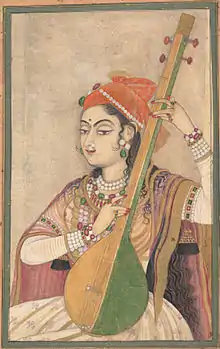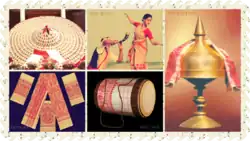Music of Assam
The music of Assam consists various genres of folk and modern music, drawing its artistic basis from the history of Assam, from Assamese culture and its ancient traditions. In recent times, starting from the late eighties, popular artistes have modernized the music catering to local popular demand.
| Music of India | |
|---|---|
 A lady playing the Tanpura, c. 1735 (Rajasthan) | |
| Genres | |
Traditional
Modern | |
| Media and performance | |
| Music awards | |
| Music festivals | |
| Music media | |
| Nationalistic and patriotic songs | |
| National anthem | Jana Gana Mana |
| Regional music | |
| |
| Part of a series on the |
| Culture of Assam |
|---|
 |
A basic characteristic of the indigenous ethnic music of Assam is its descending scale similar to East Asian music which distinguishes it from the Mode-based or folk music (Raaga-based) forms from the rest of India.
The tunes are structured in a pyramid and are in always in pentatonic scale similar to other traditional music of Asia like China, Mongolia etc and dissimilar from the seven-scaled Indian music, (in contrast to the music of rest of India which is Meend based),[4] such as the Bihu songs, (common in South-East Asia and East Asia) besides languorous music of other forms.
The legend of Princess Usha of Sonitpur and her cohort Chitralekha also enlighten us on the musical expertise of the Assamese women. The connoisseurs however, have divided the classical Assamese music into two parts – Borgeet and Ojapali. The composers of Borgeets, Sankardev and his disciple Madhavdev added versatility to Assamese music.
Musical genres
Musical instruments
Early contributors to Assamese music
- Ambikagiri Raichoudhury
- Anima Choudhury
- Bishnuprasad Rabha
- Bhupen Hazarika
- Dipali Barthakur
- Jayanta Hazarika
- Jyoti Prasad
- Khagen Mahanta
- Madhavdeva
- Parvati Prasad Baruva
- Patina Baruah
- Rameshwar Pathak
- Sankardev
- Moghai Oha
- Tarulota Bori Mili
Other notable composers, musicians and singers
References
- "639 Identifier Documentation: aho – ISO 639-3". SIL International (formerly known as the Summer Institute of Linguistics). SIL International. Retrieved 2019-06-29.
Ahom [aho]
- "Population by Religious Communities". Census India – 2001. Ministry of Home Affairs, Government of India. Retrieved 2019-07-01.
Census Data Finder/C Series/Population by Religious Communities
- "Population by religion community – 2011". Census of India, 2011. The Registrar General & Census Commissioner, India. Archived from the original on 25 August 2015.
- "ITC Sangeet Research Academy". www.itcsra.org. Retrieved 2019-10-15.
- Phukan, Mitra (2003) Musical Identity and being an Assamese, , October 2003.
- Assam Portal